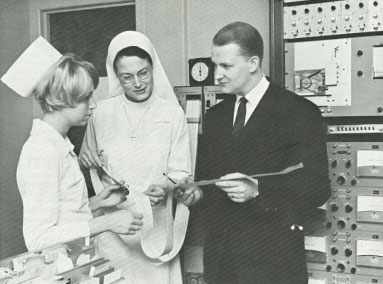-
Health & Wellness
#ThrowbackThursday: ‘Nurse Coordinator’ Concept Helps Improve Patient Care

This article first appeared October 16, 1970 in the publication Mayovox.
Nurses at both Methodist and Saint Marys Hospitals in recent months have stepped back from their everyday routines to take a long look at that most complex of entities, the modern hospital, and to re-examine their role in its operation.
One result of this re-examination has been the creation of a new position—the nurse coordinator.
Who fills these new positions? Quite possibly the same nurse, who, in a less well defined role, was dissipating her energies in areas not directly related to patient care, and underusing her potential as a professional nurse.
At Saint Marys the nurse coordinator has been functioning since mid-1969. More recently at Methodist Hospital five nursing supervisors have completed a “Reorientation to Nursing Leadership” course and have assumed their new title.
Directors of nursing service at both hospitals—Mrs. Joyce Kulas at Methodist and Sister Kateri at Saint Marys—reflect the enthusiasm of the nurse coordinators themselves in their appraisal of the change: It is (or it’s going to be) the best thing that’s happened in years.
Sister Kateri feels there is excellent acceptance by consultants of the new nurse coordinator.
“What I hear from physicians in committee meetings and in off-the-cuff comments is all good. The physician recognizes the contributions the nurse coordinator is making to patient care.”
At Methodist Hospital, starting point for re-examining the role of the nurse was a review of the philosophy and beliefs of Methodist Hospital Nursing Service. Among them:
“The Nursing Service believes it is their prime responsibility to provide safe, effective nursing care to every patient…..To accomplish this it is necessary to be mindful of the physical, spiritual and social needs of the patient….
“Patients, both hospitalized and ambulatory, are people who are, or may be, in trouble and sometimes in peril. These people need and deserve to be ‘cared for’ and cared about’.”

In addition, says Mrs. Kulas, “we looked at the patient and what we had to give him and decided how that best could be done.”
To ‘look at the patient’ is to see him as an individual: one whose life pattern has influenced his illness and will influence his well-being after he leaves the hospital. To consider ‘what we have to give to him’ is to recognize that the nurse has a role beyond carrying out the physician’s orders whereby in her own right she assumes a responsibility toward setting and meeting goals in restoration of the patient to the highest degree of well-being possible for him to attain and toward planning for his continued well-being after he leaves the hospital. To decide ‘how best that could be done’ is to develop an organization in which each person involved in patient care can develop to her full potential.
The nurse (and the word is used collectively) is the most stable element on the patient’s horizon. The patient may see his doctor (or doctors) once or twice a day. Therapists, laboratory technicians, other paramedical personnel, serve him for limited periods of time. A nurse is always there, twenty-four hours a day, seven days a week.
The nursing team at Methodist Hospital includes the nurse coordinator, head nurse, staff nurses (RNs and LPNs), aides and attendants. At St. Marys two other titles apply: the clinical coordinator and nursing consultant. (A clinical coordinator in medical cardiology and a psychiatric-mental health nursing consultant are functioning at Saint Marys. Their role is that of liaison, resource person and consultant for nurses, medical staff, patients and their families in the two areas.)
As head of the nursing team the nurse coordinator assists the head nurse in planning for the total nursing care and shaping it to the particular needs of the patient. She is a resource person for members of the nursing team to assist them to better fulfill their responsibilities and to reach their full potential. She is called on to assist in the planning for the Nursing Service Department and has a voice in its administrative decisions.
Another new role title in both hospitals is “Unit Manager.”
Unit managers are non-nursing personnel trained to relieve the professional nurse from duties unrelated to patient care. These include many clerical duties as well as responsibilities for supplies and equipment. Long-term goal of a training program at Methodist, headed by Miss Ruth Bushee, is “to have unit managers 16 hours a day, 7 days a week” in all nursing units.
At both hospitals, classes, workshops, seminars and lectures are continually in progress to help nurses keep abreast of new developments and encourage them by sharing of experience and problems to creatively contribute to improvements in patient care.
Who gains from these endeavors: the hospitals, where shortage of nurses demanded better utilization of staff; the nurses who are given greater opportunity to utilize their special skills, and most of all the patient who is ‘cared for’ and ‘cared about’.
“It’s much more than just giving a nurse a new title,” states Mrs. Kulas.
It is, in fact, a fundamental change in nursing service whose full impact will most certainly be an important factor in the hospital of tomorrow.







